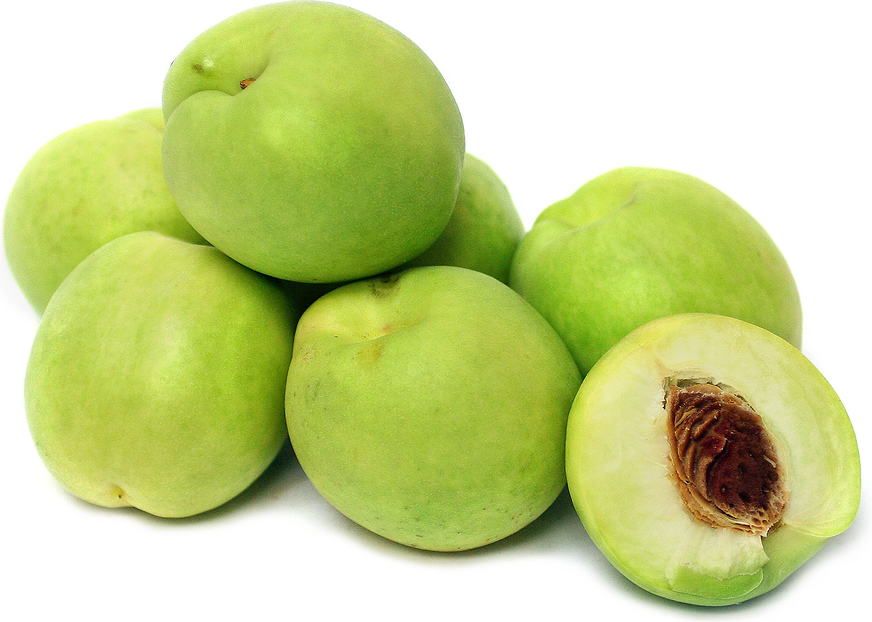


Honeydew Nectarines
Estimated Inventory, 10 lbs : 0
Description/Taste
Honeydew nectarines are small fruits, averaging 5 and 8 centimeters in diameter, and have a round, oval, to cordate shape with a central suture that extends from the stem to the tip of the fruit. The variety is typically smaller than other nectarine cultivars, and the skin is light to pale green with a smooth and taut consistency. Underneath the surface, the flesh is also pale green, dense, aqueous, and succulent, encasing a large, dark brown pit. The pit is a freestone type, meaning it is loosely adhered in the flesh, separating easily when opened. Honeydew nectarines contain low acidity and a high sugar content, developing a sweet, honeyed flavor with subtle fruity, floral, and tangy nuances.
Seasons/Availability
Honeydew nectarines are available for a short time in the mid-to-late summer.
Current Facts
Honeydew nectarines, botanically classified as Prunus persica var. nucipersica, are a rare variety belonging to the Rosaceae family. The pale green fruits were developed in California and are a boutique cultivar primarily grown by specialty orchards and home gardeners. Honeydew nectarines earned their fruity moniker from their light green coloring, similar to the color of a honeydew melon, but despite its melon name, the nectarines are not a cross between a melon and stone fruit. Honeydew nectarines are a hybrid between several pale green-white nectarine varieties. Historically, some of the original nectarine varieties in Asia were known to have a pale skin tone, and it wasn’t until the mid-20th century that red blushed fruits became the dominant type of nectarines. In the present day, Honeydew nectarines are challenging to find as they are only in season for a couple of weeks. The variety is a novelty fruit mainly grown in California, and the fruits are also cultivated in some home gardens of stone fruit enthusiasts as a rare and collectible variety for fresh eating.
Nutritional Value
Honeydew nectarines, like other nectarine varieties, are a good source of vitamins A and C to strengthen the immune system, boost collagen production within the skin, and reduce inflammation. The fruits are also a source of vitamin E to protect cells against free radical damage, fiber to regulate the digestive tract, minerals such as potassium, calcium, and magnesium, and provide lower amounts of iron, vitamin K, and folic acid.
Applications
Honeydew nectarines have a sweet, juicy nature well suited for fresh preparations. The fruits are primarily eaten straight, out of hand, and since the cultivar is rare, they are commonly consumed in their most natural form to appreciate their full flavor. Honeydew nectarines can be sliced and displayed on cheese or crudité platters, tossed into salads, diced into coleslaws, or mixed into fruit bowls. The nectarines can also be incorporated into yogurt, pudding, and breakfast bowls, chopped into salsa, blended into smoothies, or used as a fresh topping over ice cream, pancakes, and crepes. In addition to using larger slices of the fruits, Honeydew nectarines can be chopped into salsa, diced and combined with cabbage as a topping for fish, pork, or chicken tacos, or finely sliced and layered into an elevated grilled cheese. Honeydew nectarines pair well with nuts such as pecans, almonds, and walnuts, celery, apple, coconut, ginger, cranberries, mint, lime, berries, and other stone fruits such as apricots, peaches, and plums. Whole, unwashed Honeydew nectarines can be stored at room temperature for immediate consumption or kept for up to one week in the refrigerator’s crisper drawer.
Ethnic/Cultural Info
Ito Packing Co. is a family-owned business based in warm and sunny Central California. The company was established in 1955 by Jim and Yukiko Ito, and the couple owned a 14-acre property with nectarine, peach, and plum trees. The fruits were hand-packed for the first couple of years, and the business was small, but over time, packing capabilities expanded, and neighbors began sending fruit from their orchards to the Itos to pack. In the present-day, the Ito Packing Co. has grown into a large-scale operation with 10 acres of packing and cold storage facilities and over 4,500 acres of land where peaches, persimmons, chestnuts, apples, grapes, blueberries, nectarines, and quince are grown. Honeydew nectarines are a boutique variety created by Ito Packing Co. and were released after the company’s success with the rare mango nectarine. Both varieties are limited in availability, have very short seasons, and are viewed as a novelty, appreciated by stone fruit enthusiasts throughout California. Despite the variety’s rarity, Honeydew nectarines have sometimes been challenging to market due to their green coloring. Consumers often view green as a sign of unripe fruits, but Honeydew nectarines remain green when mature and offer a very sweet, pleasant flavor.
Geography/History
Honeydew nectarines were developed through traditional cross-breeding techniques, utilizing several unknown pale skin and white flesh nectarine varieties. The cultivar was created in the orchard of Ito Packing Co. in Reedley, California, and the parent varieties were said to be natural mutations or sports found growing on the branches of different nectarine cultivars. Honeydew nectarines were propagated and released in the late 20th and were believed to have been developed by Jim Ito, owner of Ito Packaging Co., along with his son-in-law David Kamada. Today Honeydew nectarines are rarely seen in commercial markets and are primarily grown by specialty orchards for farmer’s markets and select distributors. The pale-skinned nectarine is also likely to be spotted in backyard orchards as a novelty cultivar.
Recipe Ideas
Recipes that include Honeydew Nectarines. One
| Oh My Veggies |
|
Nectarine and Avocado Salad with Ginger-Lime Dressing |
| Pen & Fork |
|
Honeydew Nectarine Smoothie |




